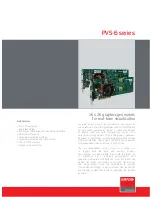
List of Illustrations
v
2
Functional Description
Figure 2-1
Block diagram of the KPCI-3110 and KPCI-3116 boards.......................................................................... 2-2
Figure 2-2
An example using dynamic digital outputs................................................................................................. 2-5
Figure 2-3
Continuous post-trigger mode without triggered scan .............................................................................. 2-11
Figure 2-4
Continuous post-trigger mode with triggered scan ................................................................................... 2-12
Figure 2-5
Continuous pre-trigger mode .................................................................................................................... 2-13
Figure 2-6
Continuous pre-trigger mode with triggered scan..................................................................................... 2-13
Figure 2-7
Continuous about-trigger mode ................................................................................................................ 2-14
Figure 2-8
Continuous about-trigger mode with triggered scan................................................................................. 2-14
Figure 2-9
Counter/timer channel............................................................................................................................... 2-23
Figure 2-10
Example of a low-to-high pulse output type ............................................................................................. 2-26
Figure 2-11
Connecting event counting signals (shown for Clock Input 0 and External Gate 0)................................ 2-27
Figure 2-12
Example of event counting ....................................................................................................................... 2-27
Figure 2-13
Connecting frequency measurement signals without an external gate input
(shown for Clock Input 0) .................................................................................................................. 2-28
Figure 2-14
Connecting frequency measurement signals (shown for Clock Input 0 and External Gate 0) ................. 2-29
Figure 2-15
Example of frequency measurement ........................................................................................................ 2-30
Figure 2-16
Connecting rate generation signals (shown for Counter Output 0; a software gate is used) .................... 2-31
Figure 2-17
Example of rate generation mode with a 75% duty cycle......................................................................... 2-31
Figure 2-18
Example of rate generation mode with a 25% duty cycle......................................................................... 2-32
Figure 2-19
Connecting one-shot signals (shown for Counter Output 0 and Gate 0) .................................................. 2-33
Figure 2-20
Example of one-shot mode using a 99.99% duty cycle ............................................................................ 2-33
Figure 2-21
Example of one-shot mode using a 50% duty cycle ................................................................................. 2-34
Figure 2-22
Example of repetitive one-shot mode using a 99.99% duty cycle ............................................................ 2-35
Figure 2-23
Example of repetitive one-shot mode using a 50% duty cycle ................................................................. 2-35
3
Installation and Configuration
Figure 3-1
Inserting a KPCI-3110 or KPCI-3116 board in the computer .................................................................... 3-6
Figure 3-2
Attaching the STP-3110 screw terminal panel to the KPCI-3110 or KPCI-3116 board ............................ 3-8
Figure 3-3
Layout of the STP-3110 screw terminal panel............................................................................................ 3-8
Figure 3-4
Removal of Jumper W1 for remote ground sensing ................................................................................... 3-9
Figure 3-5
Connecting single-ended voltage inputs (shown for Channels 0, 1, and 8).............................................. 3-14
Figure 3-6
Connecting pseudo-differential voltage inputs (shown for Channels 0, 1, and 8).................................... 3-15
Figure 3-7
Connecting differential voltage inputs (shown for Channel 0)................................................................. 3-16
Figure 3-8
Connecting differential voltage inputs from a grounded signal source (shown for Channel 0) ............... 3-17
Figure 3-9
Connecting current inputs to the STP-3110 screw terminal panel (shown for Channel 0)....................... 3-17
Figure 3-10
Connecting analog output voltages to the STP-3110 screw terminal panel (shown for Channel 0) ........ 3-18
Figure 3-11
Connecting digital inputs to the STP-3110 screw terminal panel (Lines 0 and 1, Bank A shown).......... 3-18
Figure 3-12
Connecting digital outputs to the STP-3110 screw terminal panel (Line 0, Bank B shown) ................... 3-19
Содержание KPCI-3110
Страница 3: ......
Страница 4: ......
Страница 7: ......
Страница 8: ......
Страница 16: ...Preface...
Страница 20: ...1 Overview...
Страница 25: ...2 Functional Description...
Страница 54: ......
Страница 55: ......
Страница 57: ......
Страница 58: ......
Страница 59: ......
Страница 61: ...3 Installation and Configuration...
Страница 66: ......
Страница 68: ......
Страница 80: ......
Страница 81: ......
Страница 82: ......
Страница 83: ......
Страница 84: ......
Страница 85: ......
Страница 86: ...4 Testing the Board...
Страница 89: ...5 Calibration...
Страница 92: ...6 Troubleshooting...
Страница 99: ...A Specifications...
Страница 111: ...B Connector Pin Assignments...
Страница 116: ...C Systematic Problem Isolation...
Страница 143: ...D Using Your Own Screw Terminal Panel...
Страница 156: ......













































